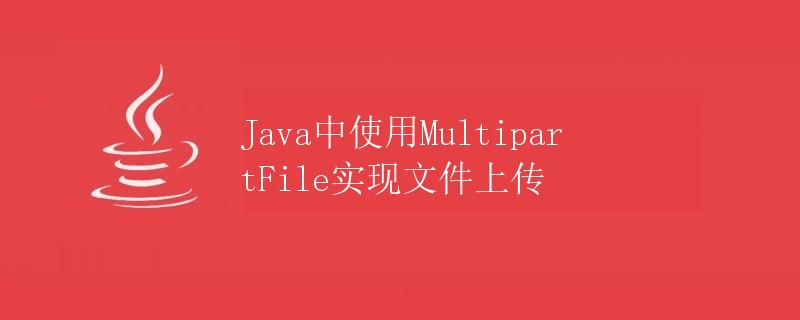Java中使用MultipartFile实现文件上传

文件上传是Web应用程序中常见的功能之一。在Java的Web开发中,我们可以使用MultipartFile类来实现文件上传功能。本文将详细介绍如何在Java中使用MultipartFile实现文件上传。
1. MultipartFile简介
在Spring MVC框架中,MultipartFile是一个专门用于处理文件上传的接口。它继承自org.springframework.web.multipart.commons.CommonsMultipartFile类,提供了一系列方法用于处理上传的文件。
MultipartFile接口定义了以下常用的方法:
- String getName():获取文件的参数名。
- String getOriginalFilename():获取原始文件名。
- long getSize():获取文件大小。
- byte[] getBytes():将文件内容以字节数组形式返回。
- InputStream getInputStream():获取文件内容的输入流。
- void transferTo(File dest):将文件内容保存到指定的目标文件。
通过MultipartFile接口提供的方法,我们可以轻松地获取上传的文件信息,并进行文件处理和存储。
2. 实现文件上传的步骤
2.1 创建表单页面
首先,我们需要在前端创建一个表单页面,用于用户选择并上传文件。以下是一个简单的表单页面示例:
<!DOCTYPE html>
<html>
<head>
<title>文件上传示例</title>
</head>
<body>
<h2>文件上传示例</h2>
<form action="/upload" method="post" enctype="multipart/form-data">
<input type="file" name="file"/>
<input type="submit" value="上传"/>
</form>
</body>
</html>
在表单的form标签中,设置了action属性为”/upload”,表示在提交表单时将请求发送到”/upload”对应的URL。method属性设置为”post”,表示使用POST方法提交表单数据。enctype属性设置为”multipart/form-data”,表示表单数据以多部分的形式进行编码。
2.2 编写文件上传的Controller
在后端,我们需要编写一个Controller类来处理文件上传的请求。以下是一个简单的文件上传Controller类的示例:
@Controller
public class FileUploadController {
@PostMapping("/upload")
public String uploadFile(@RequestParam("file") MultipartFile file, RedirectAttributes redirectAttributes) {
if (file.isEmpty()) {
// 上传文件为空
redirectAttributes.addFlashAttribute("message", "请选择一个文件进行上传!");
return "redirect:/uploadStatus";
}
try {
// 获取上传文件的原始文件名
String originalFileName = file.getOriginalFilename();
// 获取上传文件的字节数组
byte[] bytes = file.getBytes();
// TODO: 处理文件保存或其他业务逻辑
redirectAttributes.addFlashAttribute("message", "文件上传成功!");
} catch (IOException e) {
e.printStackTrace();
redirectAttributes.addFlashAttribute("message", "文件上传失败!");
}
return "redirect:/uploadStatus";
}
}
在Controller类中,我们使用@Controller注解将其声明为一个Spring MVC的Controller组件。@PostMapping("/upload")注解表示该方法处理”/upload” URL的POST请求。
方法的参数中使用@RequestParam("file")注解将上传的文件绑定到MultipartFile类型的file参数上。RedirectAttributes参数用于在重定向之间传递消息,我们可以使用addFlashAttribute()方法在重定向后将消息传递给下一个请求。
在方法中,我们首先使用isEmpty()方法判断上传的文件是否为空,如果为空则重定向到一个错误页面,提示用户选择一个文件进行上传。
接下来,我们使用getOriginalFilename()方法获取上传文件的原始文件名,使用getBytes()方法将文件内容以字节数组形式返回。
在实际应用中,我们可以根据需要进行文件的保存或其他业务逻辑。这里所做的只是通过addFlashAttribute()方法将一个提示消息传递给重定向后的请求。
最后,我们返回”redirect:/uploadStatus”,将请求重定向到”/uploadStatus” URL。
2.3 创建上传成功页面
需要在controller返回成功时为用户展示一个成功上传的页面。以下是一个简单的成功页面示例:
<!DOCTYPE html>
<html>
<head>
<title>文件上传状态</title>
</head>
<body>
<h2>文件上传状态</h2>
<p th:text="${message}"></p>
<p><a href="/upload">返回</a></p>
</body>
</html>
在页面的p标签中,使用th:text="${message}"从后端获取并展示上传状态的消息。
2.4 配置文件上传相关的Bean
要启用文件上传功能,我们还需要在Spring配置文件中添加一些特定的Bean。以下是一个简单的Spring配置文件示例:
<?xml version="1.0" encoding="UTF-8"?>
<beans xmlns="http://www.springframework.org/schema/beans"
xmlns:xsi="http://www.w3.org/2001/XMLSchema-instance"
xmlns:mvc="http://www.springframework.org/schema/mvc"
xsi:schemaLocation="http://www.springframework.org/schema/mvc http://www.springframework.org/schema/mvc/spring-mvc-4.3.xsd
http://www.springframework.org/schema/beans http://www.springframework.org/schema/beans/spring-beans-4.3.xsd">
<mvc:annotation-driven/>
<bean id="multipartResolver" class="org.springframework.web.multipart.commons.CommonsMultipartResolver">
<property name="maxUploadSize" value="52428800"/>
<property name="maxInMemorySize" value="4096"/>
</bean>
</beans>
以上示例中,我们首先使用xmlns:mvc声明了Spring MVC的命名空间。然后,我们使用mvc:annotation-driven配置了MVC注解驱动。
接下来,我们使用<bean>元素定义了一个名为”multipartResolver”的Bean,并指定了其类型为org.springframework.web.multipart.commons.CommonsMultipartResolver,该类是Spring提供的一个用于处理文件上传的解析器。
在<property>元素中,我们可以设置解析器的一些属性。maxUploadSize属性用于限制上传文件的最大大小(单位为字节),maxInMemorySize属性用于设置内存中的最大缓存大小。
3. 示例代码运行结果
假设我们选择一个名为”helloworld.txt”的文本文件进行上传,在成功上传后,页面会显示”文件上传成功!”的提示消息,并提供一个”返回”链接。
结论
使用MultipartFile接口可以在Java中实现文件上传功能。通过创建表单页面、编写Controller类、创建上传成功页面以及配置相关的Bean,我们可以方便地实现文件上传并处理上传的文件。
 极客笔记
极客笔记